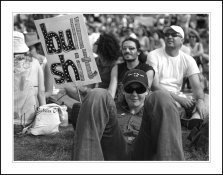John McCallum
Member
Yes, well put.
But we're missing an important ingredient (unless I've missed it somewhere) when it comes to the ability to readily interpret the likes of work by Norfolk, and so properly discuss it - that is Proper Context. As Bjorke so easily showed earlier, images taken out of context can very easily be missinterpreted or inadequately interpreted.
There's a reason why such message charged images work better on display in a gallery with the carefully controlled environment of titles, support text and if that weren't enough the selective audiences by promotion, and a curator to guide your thoughts while you're there. And in my experience a politically charged contemporary image can initially give a far more enriching experience.
As an example of the influence of context. If I'd been told this image had been made by Mark Citret or say Donny Miler, it would have had x appeal for me.

Staircase at Auschwitz
Knowing it was made by Norfolk in the context he intends prompts me to view the associated message, and makes it one of the more affecting images I have seen.
I agree pictures and especially photographs need to be free to enable frank discussion - photographs esp. because in other art it is often clearer as to whether there is an intentional message. The social acceptance or not of discussion or images seems to be quite pervading, and so it seems odd that political messages in images are not readily accepted by some, given that the fundamental meaning of politics is the influence of social relations in order to affect change. I suspect that those who declare themselves apolitical perhaps do so to avoid discussions, either that or are naive in the thought politics does not or should not exist in images such as Norfolks'.Heh, well as my dad used to say at little league practice: "just keep pitching 'em slow, sooner or later somebody'll swing at it."
Actually ALL the images I've posted are technically-proficient romanticisations becuase those are exactly the sorts of art that restrictive governments like. The first one is from the studio of Josef Thorak.
jstraw's "bread & circus" comment made an excellent hammer btw.
My point, really, is to simply say that pictures need to be free, and discussion of pictures needs to be free. I find it odd that threads get bounced to the Soapbox because they mention, oh, Fox News, but at the same time images that are HIGHLY codified with a wide variety of political content (e.g, partial inert female nudes, where individual portraiture is de-synergized into collections of interchangeable parts) is accepted without a whiff of complaint.
As I expected, those who proclaimed themselves apolitical seem to have had the most reactionary and vitriolic reactions. Funny how that works, huh.
But we're missing an important ingredient (unless I've missed it somewhere) when it comes to the ability to readily interpret the likes of work by Norfolk, and so properly discuss it - that is Proper Context. As Bjorke so easily showed earlier, images taken out of context can very easily be missinterpreted or inadequately interpreted.
There's a reason why such message charged images work better on display in a gallery with the carefully controlled environment of titles, support text and if that weren't enough the selective audiences by promotion, and a curator to guide your thoughts while you're there. And in my experience a politically charged contemporary image can initially give a far more enriching experience.
As an example of the influence of context. If I'd been told this image had been made by Mark Citret or say Donny Miler, it would have had x appeal for me.

Staircase at Auschwitz
Knowing it was made by Norfolk in the context he intends prompts me to view the associated message, and makes it one of the more affecting images I have seen.
Last edited by a moderator:













